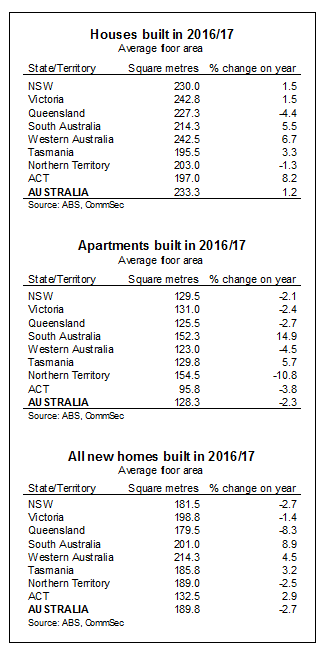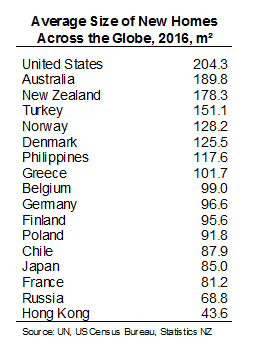Australian home size hits 20-year low: CommSec report
The average floor size of an Australian home (houses and apartments) has fallen to a 20-year low, though latest data indicates that Australian homes are the second biggest in the world, behind the US.
Data commissioned by CommSec from the Australian Bureau of Statistics, shows the average new home is 189.8 square metres, down 2.7 per cent over the past year and the smallest since 1997.
The smaller home size can be attributed in a major way to the increased apartment construction, CommSec said in the report.
Although free-standing houses are still bigger.
In fact, the average new house built in 2016/17 was 233.3 square metres, the biggest in four years and more than 11 per cent bigger than 20 years ago.
The average house built today is over 30 per cent bigger than 30 years ago (the 1986/87 financial year).
On average, US houses are still bigger by around 5 per cent. And US homes (houses and apartments) are 8 per cent bigger.

Victorians are building the biggest houses in Australia, ahead of Western Australia and NSW. But the average size of houses built in South Australia in 2016/17 was the biggest in the state’s history.
In fact, the size of the average new house has grown slightly over the past two years.
House sizes are important when comparing prices over time, the CommSec report says.
“Not only are houses far bigger than those built in the 1980s and before, but the standard of fit-out today is far superior with quality kitchens, bathrooms, floor coverings and inclusions like air-conditioners,” it said.
Compared to US, Australian homes are the second biggest in the world.
The average new house built in the US last calendar year (latest available) was 245 sqm, around 5 per cent bigger than in Australia. And US homes (houses and apartments) averaged 204 sqm in 2016, around 8 per cent bigger than in Australia.

Neighbouring New Zealand is not far behind, with the average home built in 2016/17 (data on houses isn’t available) being 178.3 sqm, around 6 per cent smaller than in Australia.
The last global survey conducted by the United Nations indicates that the average floor area of new homes built in US, Australia and New Zealand were far larger than in other European economies.
In recent years a key trend in Australia has been the rise in construction of apartments, which now make up nearly half of all homes built unlike seven years ago when only around 27 per cent of homes built were apartments.
The increase in the number of apartments being built has reduced the size of the average home in Australia.
In fact the average home was 189.8 sqm in 2016/17, the lowest level in 20 years and down 2.7 per cent on a year ago.
Through the 2004-2009 period, the average apartment was around 140 sqm. Today, it is closer to 130 sqm.
“The shift to smaller apartments may mean that more of them need to be built to house the growing population compared with free-standing houses. And this point emphasises that when considering issues like under-supply and over-supply, a range of issues need to be considered,” says the report.
Five years ago economists were baffled by the failure of home building to lift to the level of assumed underlying demand. However the “apparent paradox” was explained by structural change such as demographics and increased utilisation of Australia’s large homes.
Now household size is falling again, and at the same time that the average home size is also falling. If current trends continue, more homes can be built without resulting in over-supply conditions. In short, supply would merely be responding to stronger demand.
“The key point being that it is not just population, but demographics and choice of accommodation driving demand,” says the report.
